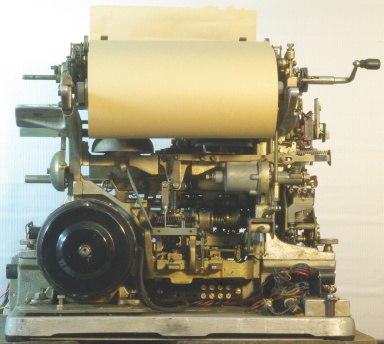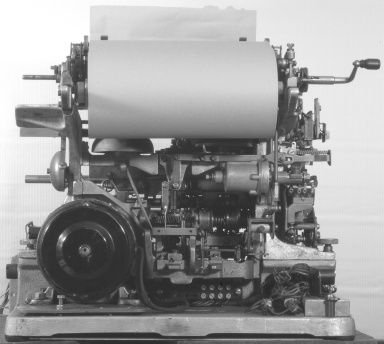This is the first Teletype page printer that I acquired. There's a big difference between just reading about stuff in books and actually seeing it in a physical machine (and trying to get it to work). This is the machine on which I'll figure out how a Teletype really works. The study of it here will, therefore, be perhaps a little more detailed than it might otherwise need to be.
Teletypes of this vintage were extremely modular. Informally, this machine would generally be called a "Model 15 KSR" (Keyboard, Send-Receive). It actually consists of a number of independent functional modules, each of which bears its own serial number. Originally it may have had more components (a line relay, for example) and it had a punch (and possibly therefore a different keyboard? I don't yet know my Teletypes well enough to know.) The serial number of the "15-C Teletypewriter Base" is 213102, and short of a complete module list might best serve to identify the machine.
Introduction and Identification
... and slightly obsessive photographs of all identification plates.

15-C Teletypewriter Base s/n 213102
[NOT DONE] For Type UA15 or UA20 Printer.

15-Y Typing Unit s/n 167037
[NOT DONE] The motor is of the constant-speed synchronous AC type (as opposed to the governed type which could run on either AC or DC).
Note: I'm photographing under compact fluorescent lights, and I haven't quite got the white balance correct in these. The photographs are distinctly more golden in tone than the machine itself (which is cast aluminum in color, with only a faint golden sheen of old oil). Actually, desaturated these photographs make pretty good black and white images. Perhaps I ought to do this for all of them? The machine was built before color photography became common, after all.


All portions of this document not noted otherwise are Copyright © 2010 by David M. MacMillan and Rollande Krandall.
Circuitous Root is a Registered Trademark of David M. MacMillan and Rollande Krandall.
This work is licensed under the Creative Commons "Attribution - ShareAlike" license. See http://creativecommons.org/licenses/by-sa/3.0/ for its terms.
Presented originally by Circuitous Root®
Select Resolution: 0 [other resolutions temporarily disabled due to lack of disk space]